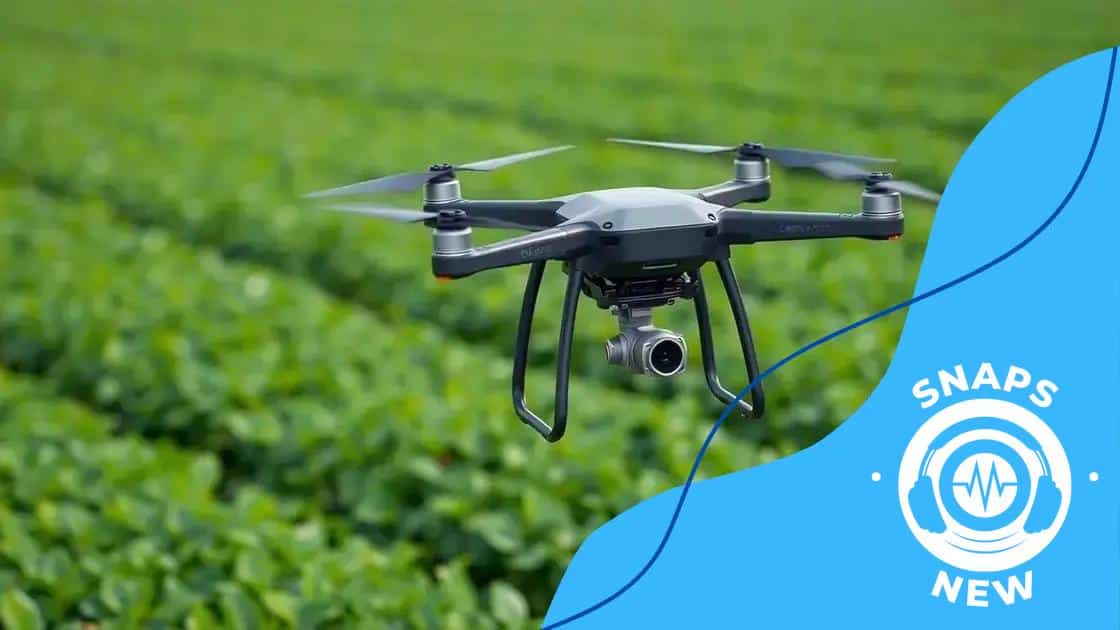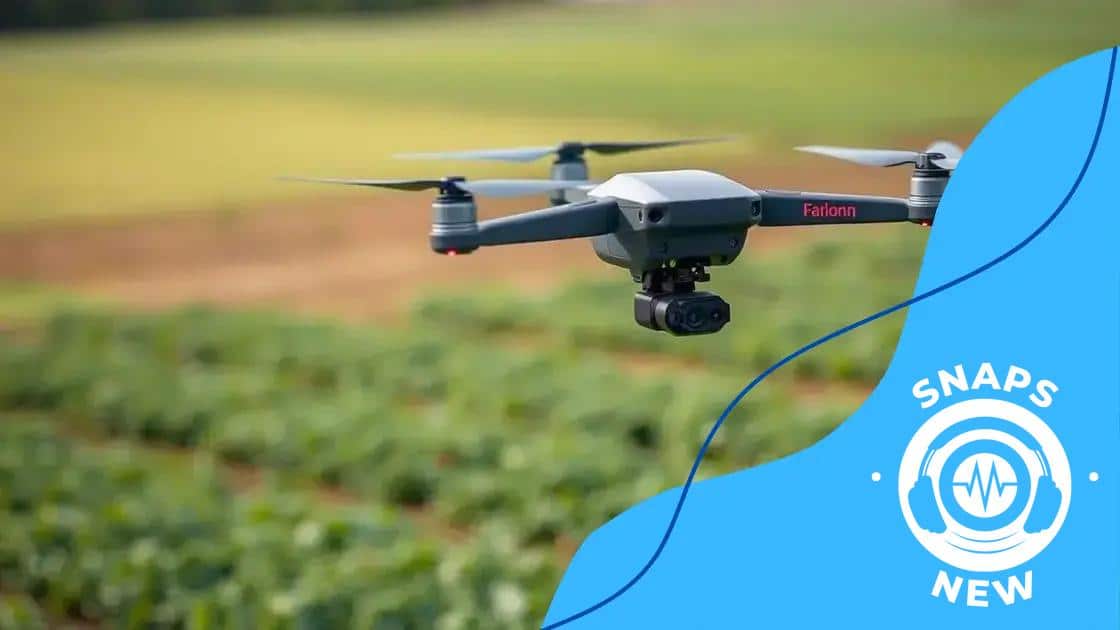Drone technology in agriculture: transforming farming

Drone technology in agriculture enhances crop management by providing efficient monitoring, precise application of inputs, and real-time data analysis, leading to improved yields and sustainable farming practices.
Drone technology in agriculture is changing the landscape of modern farming. Imagine having the ability to survey vast fields with just a few clicks. Intrigued? Let’s dive into how these flying devices are making waves in the agricultural sector.
Understanding drone technology in agriculture
Understanding drone technology in agriculture involves recognizing how these advanced tools help farmers enhance crop management. Drones are becoming a crucial part of modern farming practices, allowing for more efficient monitoring and data collection.
These flying devices offer various functionalities that benefit farmers. One key aspect is their ability to capture high-resolution images of fields. With these images, farmers can assess crop health and identify areas that may need attention.
Key Features of Drones in Agriculture
Drones equipped with specialized sensors can perform various tasks effectively. They can monitor crop conditions, apply pesticides, and even plant seeds. The integration of drone technology in agriculture is transforming traditional farming methods.
- High-resolution imaging for crop monitoring
- Real-time data collection for timely decision-making
- Ability to cover large areas quickly
- Reduction in manual labor and operational costs
Moreover, drones can fly at various altitudes, enabling them to capture detailed images that may reveal different aspects of plant health. By analyzing the collected data, farmers can make informed decisions about irrigation, fertilization, and pest control. This leads to improved yield and sustainability.
The use of drones promotes precision agriculture, which focuses on efficient resource use. This technique minimizes waste and helps maximize the productivity of the land. In the long run, adopting drone technology contributes to environmental stewardship by reducing the overall chemical runoff into nearby ecosystems.
Benefits of using drones in farming
The benefits of using drones in farming are numerous and impactful. Farmers can significantly enhance their productivity and efficiency through advanced drone technology. These devices enable better crop monitoring, precise applications of inputs, and more informed decision-making.
One of the major advantages is the ability to collect real-time data. Drones can gather high-resolution images and data about crop health from different angles, allowing for comprehensive assessments. This technology supports a proactive approach, where farmers can address issues before they escalate.
Key Advantages of Drone Usage
Utilizing drones offers several key benefits that improve farming practices. These include:
- Increased efficiency in monitoring crop conditions
- Reduced costs associated with traditional scouting methods
- Enhanced accuracy in applying fertilizers and pesticides
- Improved crop yields by addressing issues promptly
Moreover, drones can cover large areas in a short time. This effectiveness translates into less time spent inspecting fields and more time managing operations. Additionally, the integration of drone technology allows for a more sustainable approach by minimizing waste and reducing chemical usage.
Farmers can also utilize data analytics tools combined with drones. This integration enables better planning and resource allocation, which ultimately leads to a more sustainable farming model. The enhanced visibility and insights provided by drones empower farmers to make data-driven decisions that positively affect their crops and land.
Key drone applications for crop management

Key drone applications for crop management have transformed the way farmers approach their work. These tools help in various tasks that enhance productivity and sustainability on farms. From monitoring plant health to mapping fields, drones provide valuable insights.
One important application is crop scouting. Drones can quickly fly over fields and gather detailed information about crop conditions. This speed means farmers can detect problems early, mitigating issues before they affect yields.
Common Drone Applications
Several specific applications show how drones can be used effectively in agriculture. These include:
- Bayer monitoring: Monitoring crop health through multispectral imaging to identify stressed areas.
- Precision spraying: Using drones for accurate pesticide or fertilizer application, reducing waste.
- Field mapping: Creating detailed maps to understand field topography and soil health.
- Irrigation management: Assessing soil moisture levels to optimize irrigation practices.
Through these applications, farmers can achieve better results with less effort. Drones not only save time but also reduce the need for manual labor, making farming more efficient. They can scan vast areas quickly, delivering data that might take hours or days to collect manually.
Another significant benefit is data analysis. Many drones come with software that processes the captured data, giving farmers actionable insights. For example, farmers can track growth patterns and make decisions to improve crop yield. This approach blends technology with traditional farming methods seamlessly.
Challenges in adopting drone technology
The challenges in adopting drone technology for agriculture can make the transition difficult for many farmers. While the benefits are clear, some obstacles need consideration. Understanding these challenges helps in making informed decisions about integrating drones into farming practices.
One major issue is the cost. High-quality drones and the necessary software can require a significant initial investment. This financial barrier can deter many farmers, especially those running smaller operations.
Common Challenges Faced
Farmers face several common challenges when incorporating drones into their workflows. These include:
- Regulations: Navigating the legal requirements and regulations regarding drone usage can be complex.
- Data management: Understanding how to interpret and manage the vast amounts of data collected by drones presents a learning curve.
- Technical skills: Farmers may need to acquire new skills to operate drones and handle the associated technology.
- Maintenance: Keeping drones in working order necessitates regular maintenance and repairs, which can add another layer of complexity.
Another challenge is weather dependency. Drones often cannot operate effectively in adverse weather conditions like heavy rain or strong winds. This limitation can affect the planning and timing of crucial farming activities.
Additionally, some farmers may feel a sense of hesitation toward adopting new technology. This reluctance can stem from relying on traditional methods that have worked for years. Overall, overcoming these challenges is essential for fully realizing the benefits of drone technology in agriculture.
Future trends in agricultural drones
Future trends in agricultural drones point toward an exciting evolution in farming practices. As technology advances, these flying tools are becoming more sophisticated, providing innovative solutions for crop management. With improvements in design and capabilities, drones are set to transform the agricultural landscape.
One significant trend is the rise of autonomous drones. These drones are designed to operate without human intervention, using advanced sensors and AI to navigate fields. This technology can streamline agricultural processes, making them more efficient and less labor-intensive.
Emerging Trends to Watch
Several emerging trends in agricultural drones are gaining attention:
- AI integration: Utilizing artificial intelligence for analyzing data collected by drones helps farmers make smarter decisions.
- Real-time data analysis: Future drones will provide immediate feedback and insights, aiding in quick decision-making.
- Enhanced imaging technology: Improvements in camera technology will allow for better crop health monitoring and identification of specific issues.
- Increased payload capacity: Enhanced payload capabilities will enable drones to perform more tasks, such as carrying larger quantities of fertilizers or seeds.
Additionally, the use of drones in precision agriculture will continue to grow. This method allows farmers to apply resources like water, fertilizers, and pesticides more effectively. By focusing on specific areas of the field, farmers can reduce waste and increase crop yields.
Furthermore, regulatory frameworks are evolving. As drone technology becomes more mainstream, governments are likely to develop rules that foster innovation while ensuring safety and privacy. This supportive environment will encourage wider adoption among farmers.
In conclusion, drone technology is transforming agriculture in many ways. From crop monitoring to precision spraying, drones are making farming more efficient and sustainable. As we look to the future, advancements in technology will bring even more exciting possibilities. While there are challenges to overcome, the benefits of adopting drones far outweigh the obstacles. Farmers who embrace these tools can expect improved yields, reduced costs, and a more sustainable approach to agriculture.
FAQ – Frequently Asked Questions about Drone Technology in Agriculture
What are the main benefits of using drones in farming?
The main benefits include increased efficiency in monitoring crops, reduced labor costs, improved accuracy in applying inputs, and better data collection for decision-making.
What challenges do farmers face when adopting drone technology?
Farmers may face challenges such as high costs, regulatory issues, data management complexities, and the need for technical skills.
How can drones help with crop health management?
Drones provide high-resolution imaging that allows farmers to identify unhealthy plants and assess crop conditions quickly and accurately.
What future trends are expected in agricultural drones?
Future trends include the rise of autonomous drones, enhanced AI integration for data analysis, and advancements in imaging technology to improve crop monitoring.





